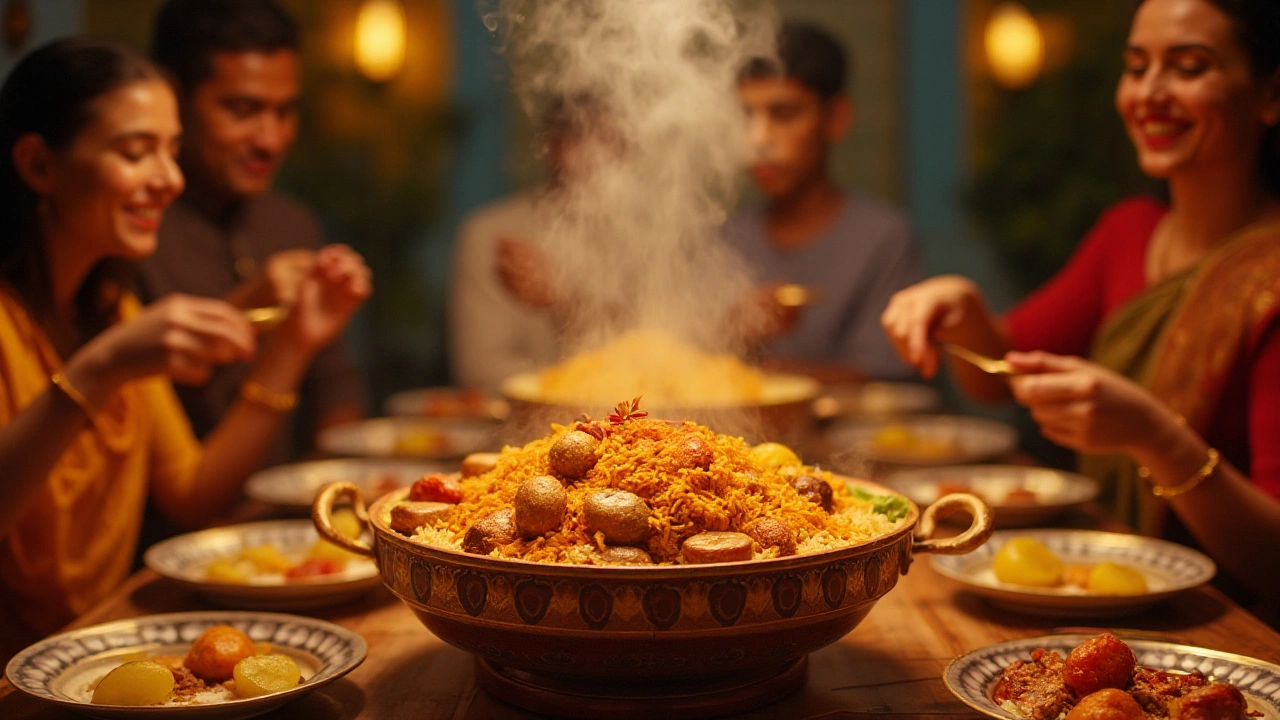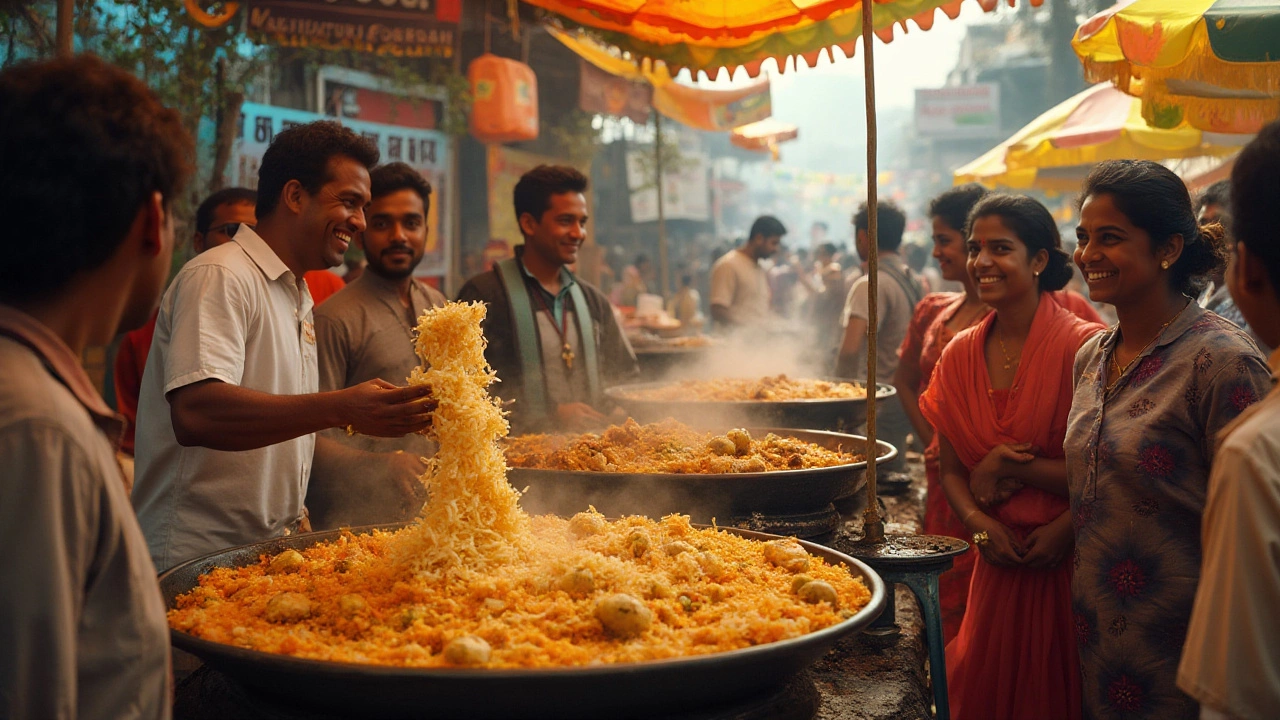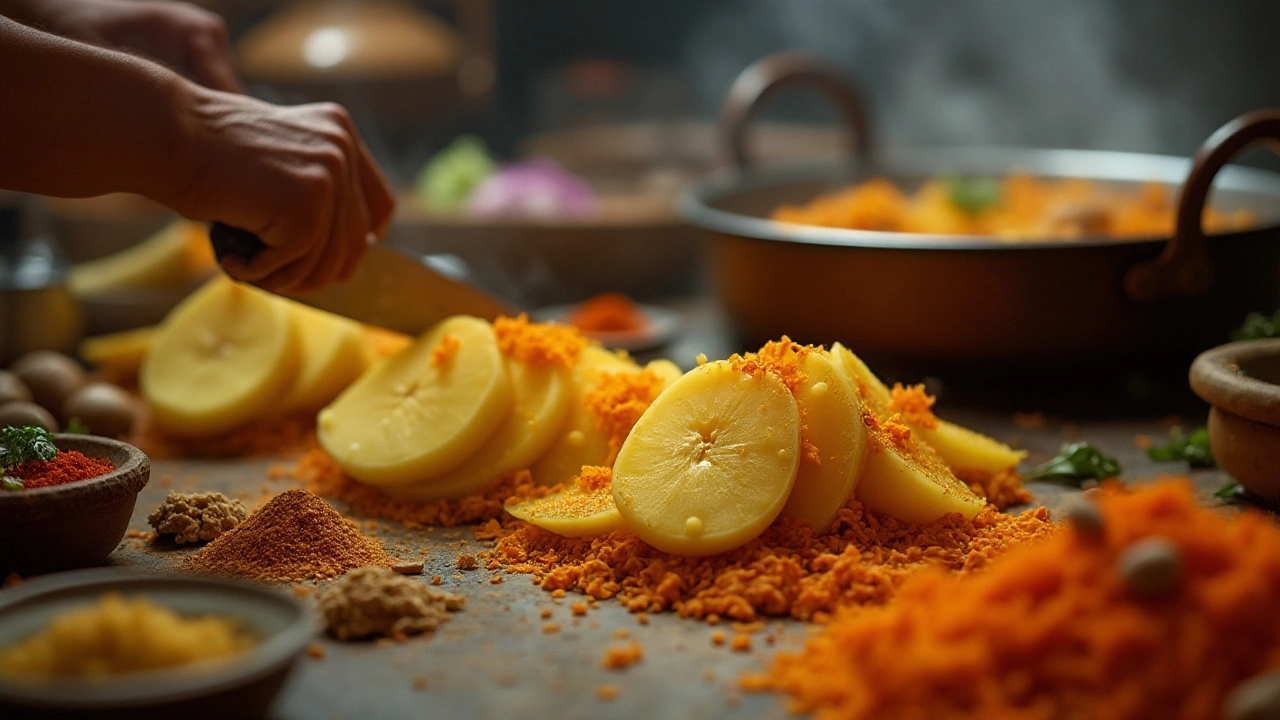2 Dec 2024
- 0 Comments
Biryani is more than just a dish; it's an aromatic tradition steeped in history and culinary charm. For many, the question of why potatoes make their way into this beloved meal is one that sparks curiosity and sometimes debate. Is it a necessary addition or a regional twist? As you delve into the layers of rice, spices, and succulent meat, there's this surprise element that has found its way into numerous recipes— the humble potato.
The tradition of adding potatoes to biryani is not universal, but in certain cultures and families, it's a practice steeped in history and flavor. This versatile tuber adds a delightful texture contrast and is known to absorb the rich aromas perfectly, enhancing the entire biryani experience. If you've been hesitant, or perhaps never really understood its presence, let's explore the reasons behind this culinary choice.
- The History of Potatoes in Biryani
- Regional Variations
- Why Potatoes Make Sense
- Tips for Perfect Potato Biryani
The History of Potatoes in Biryani
Biryani, a masterpiece of Indian cuisine, has a rich history that reflects the diverse cultures it traversed and touched. The inclusion of potatoes in biryani, though, is an interesting twist many have witnessed in this culinary journey. Historical records suggest that biryani, with its origins likely in Persia, traveled to India with the Mughals, embracing local flavors and ingredients. In regions like Kolkata, known for its distinctive Kolkata biryani, the addition of potatoes is attributed to cost-saving measures under Nawab Wajid Ali Shah's rule in the mid-19th century. The Nawab, exiled from his lavish Lucknow, tried to recreate his favorite dish. Economic constraints led to the innovative use of potatoes—bulbous, filling, and inexpensive—as a way to substitute for meat.
"Potatoes were not mere fillers, but soon became an integral taste that many associated with biryani." — Culinary Historian, Pushpesh Pant
The marriage of flavors between potatoes and biryani is not just a result of economic necessity but also a remarkable instance of culinary adaptability. Over time, the addition of potatoes took a symbolic role, representing a fusion of tradition and innovation. Across India, certain communities embraced this evolution, from the pageantry-rich land of Bengal, where the potato became a cherished ingredient in biryani, the dish was esteemed for its carbs and its hearty nature, perfect for industrial growth periods demanding energy-rich food. Indian cuisine, known for its flexibility, saw this shift in taste and utility warmly. Today, even as people remain divided on the validity of this spud addition, the humble potato continues to enjoy its rightfully earned space, particularly in recipes that prioritize texture and flavor harmony.
This adaptation gave rise to various regional variations, each putting its unique stamp on biryani. South Indian versions, like the one from Kerala, sometimes incorporate potatoes, infusing them with local spices for added zest. As you travel from state to state, the perception of what a true biryani should contain evolves, but the potato remains a constant guest in its culinary story, celebrated for its simplicity and its ability to elevate a dish to new gastronomic heights. It’s a testament to how food continuously adapts and morphs to suit societal and economic contexts, yet still finds a way to be delightfully delicious and remarkably resourceful.

Regional Variations
Across the vibrant tapestry of Indian cuisine, the inclusion of potatoes in biryani reflects a fascinating story of regional preferences and historical adoption. In places like Kolkata, this tradition is more than just a culinary choice; it's a beloved legacy. The Bengal region adopted the addition of potatoes during the colonial era, where the Portuguese influence introduced the tuber as a staple. The Bengalis embraced it warmly, incorporating it into their biryani recipe, thus evolving a signature variant known as the Kolkata Biryani. This biryani doesn't just include potatoes; it celebrates them. The potatoes absorb the delectable spices and flavors during the slow cooking process, and in some kitchens, they are even lovingly fried before being layered with rice. It's an experience that transports you to the heart of Kolkata's culinary ethos.
On the other hand, the Lucknowi or Awadhi Biryani typically stands out with its focus on delicate flavors and perfumes, almost always devoid of potatoes. Showing their roots in the royal kitchens of the Nawabs, these biryanis emphasize the meat and rice layering technique. However, in recent times, a few innovative chefs, bending traditional norms, have started experimenting by integrating potatoes to appeal to a broader palate. The Hyderabadi Biryani paints a different picture, often being aligned more with the Mughlai influences, focusing heavily on rich gravies and marination of meat. Hyderabadi cooks might not traditionally add potatoes, but the adaptation can sometimes be seen in home kitchens, where every ingredient speaks of the fusion of cultures unique to Hyderabad.
As biryani transcended borders and became a staple in places like Pakistan and Bangladesh, each version brought something unique to the table. The Sindhi Biryani in Pakistan is known for its strong flavors and spiciness, occasionally including potatoes. Meanwhile, in Bangladesh, the Dhakai Biryani is noted for its subtle flavors, and in some areas, potatoes are particularly favored, reflecting the agricultural abundance of the country. It is interesting to see that even outside the Indian subcontinent, in countries with a substantial Indian diaspora such as Malaysia and South Africa, potatoes are sometimes included in local adaptations of biryani.
"In an intricate culinary dance, culture and flavor find harmony in biryani, turning each regional variant into a story steeped in tradition," notes food historian Pushpesh Pant.As you explore these variations, it becomes clear that potatoes in biryani aren't just an added ingredient; they're a cherished part of family recipes passed down through generations. Each pot of biryani tells a tale of the people who make it and the land they belong to, showing how cooking tips and culinary customs travel through time and space, ensuring biryani remains a beloved dish irrespective of its regional twists.

Why Potatoes Make Sense
Many food lovers have pondered the question of adding potatoes into their biryani recipe. Some argue that it's a regional peculiarity, while others believe it's a stroke of culinary brilliance. The truth is, potatoes bring a unique balance to the mix. They have this magical ability to soak up spices and aromas, enriching the dish significantly. As these spuds absorb the medley of spices, they transform into bite-sized ambassadors of flavor. Each piece becomes a little parcel of taste, offering a contrast to the rice and meat, intriguing and comforting at the same time.
In terms of texture, potatoes play a crucial role. They introduce a pleasing, tender consistency that complements both the fluffy rice and juicy meat or vegetables. When cooked to perfection, they offer a slight resistance to the spoon, breaking apart with a gentle squish that releases steam laced with aromatic notes. This texture variation is not just about a sensory delight; it adds a layer of complexity that elevates the dish from merely satisfying to genuinely fulfilling. The inclusion of potatoes seems to foster harmony within the pot, turning a simple dish into a symphony of elements working in concert.
Nutritionally, incorporating potatoes into biryani isn't just an aesthetic choice; it's a thoughtful decision. Potatoes are rich in essential nutrients such as vitamin C, potassium, and fiber. They can bolster the meal’s nutritional profile, making it not just a treat for the taste buds but also a boon for health. For families who depend on one-pot meals, potatoes offer an economical way to stretch the dish further while keeping it wholesome. This approach can be particularly important for larger families or those on a budget, looking to create something both plentiful and nourishing.
"The potato is a vegetable that plays well with many dishes, taking on the role of a supportive actor who elevates the lead," says renowned chef Nigella Lawson, capturing its essence perfectly.
There is also the undeniable appeal of tradition. In many Indian homes, biryani with potatoes is not just food; it's a nostalgic journey. This addition might have stemmed from necessity during times when stretching a meal was crucial, morphing into a beloved tradition over centuries. For those who grew up with the comfort of velvety potatoes nestling amidst spiced rice, the combination is an indispensable taste of home. It's these personal and cultural associations that can make or break a dish, drawing people together over shared flavors and stories.
If you're considering enhancing your biryani, don't simply discard the idea of potatoes. Embrace it and experiment with different types and cooking methods. You might try roasting them first for a crispy exterior or adding them raw to soak up more of the simmering spices. For an even richer dish, consider using a touch of saffron-infused milk or lemon zest to brighten and deepen the flavor profile at the same time. The next time you plan your cooking tips session on an Indian meal, make room for potatoes. You might find that they don't just make sense in biryani, they make it unforgettable.

Tips for Perfect Potato Biryani
Creating the perfect biryani, especially when incorporating potatoes, is more of an art than a stringent science. The inclusion of potatoes can turn an ordinary biryani into a hearty, flavorful experience. First, selecting the right type of potato is crucial. Many cooks recommend using waxy potatoes because they hold their shape better during the cooking process. Floury potatoes, on the other hand, tend to break down and can become mushy, altering the desired texture of the dish. For those seeking uniformity and an even cook, consider cutting the potatoes into cubes that match the size of your meat pieces. This ensures that both elements cook at the same rate, leading to a balanced dish.
Proper seasoning of the potatoes before cooking is another secret to perfecting this dish. Marinating them with the same spices used in the biryani helps them soak up all the lovely aromas. Don’t shy away from using your favorite spices, but be mindful of balance. Too much of a single spice can overpower the dish, while too little can make the flavors flat. Aim for a medley of saffron, cumin, coriander, and star anise to make a fragrant symphony in your kitchen. Some seasoned chefs like to fry potatoes in ghee until golden before adding them to the biryani. This not only adds a rich flavor but also accelerates the cooking process.
The cooking process also plays a significant role in achieving the desired results. Whether you prefer the stovetop method or opt for an oven bake, maintaining a consistent low heat is vital. This allows the flavors to meld and seep into every grain of rice and potato cube, without burning any of the elements. Adding just the right amount of water is essential, too. Too little can cause the rice to stick to the bottom, while too much can make the biryani soggy. When cooking, a ratio of 1.5 cups of water for every cup of rice is often recommended.
Resting the biryani after cooking is a crucial, yet often overlooked, step. Allowing the dish to sit undisturbed for a short while ensures the flavors settle and intensify, making each bite more satisfying. As a final garnish, some cooks like to top their biryani with crispy fried onions or a sprinkle of cilantro. This adds not only a pop of flavor but a delightful texture to contrast with the soft potatoes in biryani.
A study by the Indian Institute of Food Technology found that properly resting biryani for at least 15 minutes post-cooking enhances aroma and taste by allowing the delicate volatile oils in spices to stabilize. If you wish to store leftovers, it's best to remove the potatoes from the biryani to prevent them from absorbing too much moisture and becoming overly soft. Instead, add fresh potatoes when reheating for an authentic taste experience.
"Biryani is not just a dish, it's a feeling that lingers in the air and on the palate long after it's savored," says renowned chef Madhur Jaffrey, underlining the emotional and sensory fulfillment that a well-cooked biryani provides.
With these tips at hand, the path to crafting a perfect biryani recipe adorned with potatoes becomes an inviting culinary journey. Whether you're cooking for a festive occasion or a delightful weekend meal, the art of biryani offers endless creativity, with potatoes providing yet another opportunity to elevate this classic dish.
